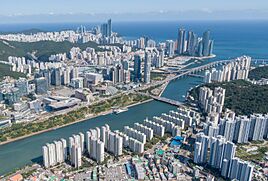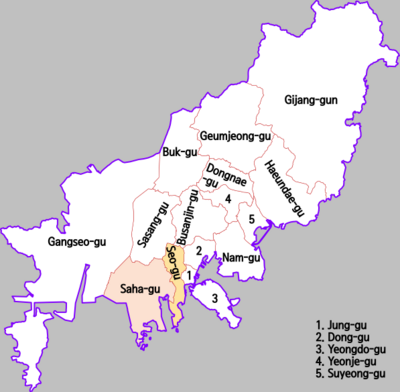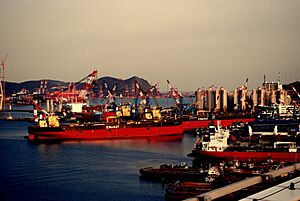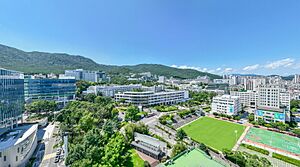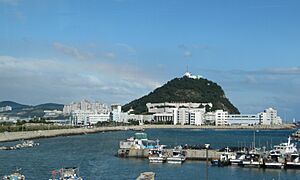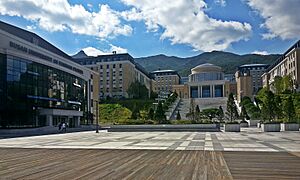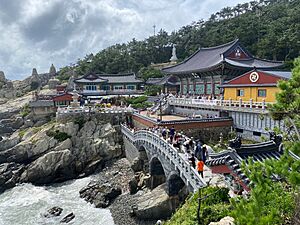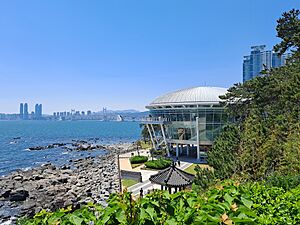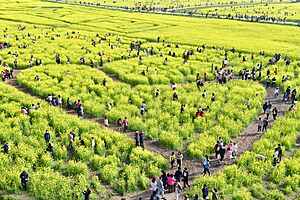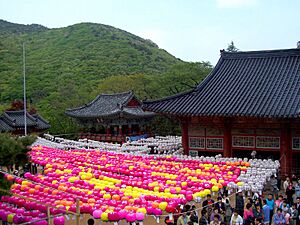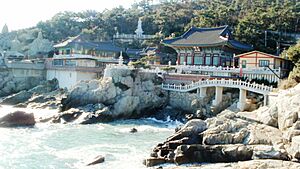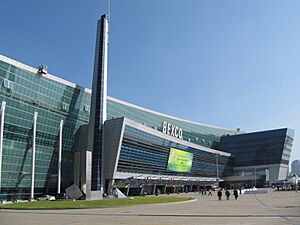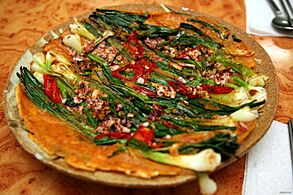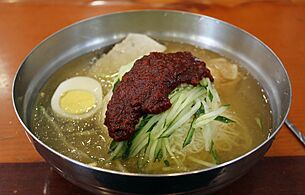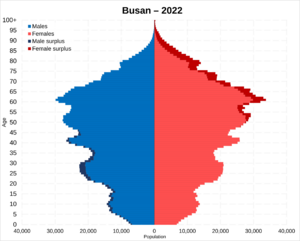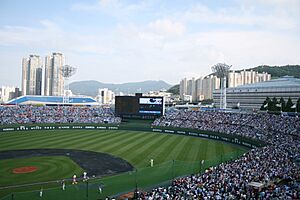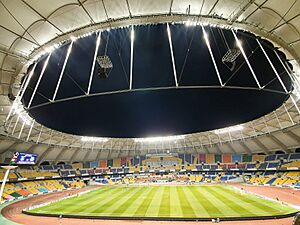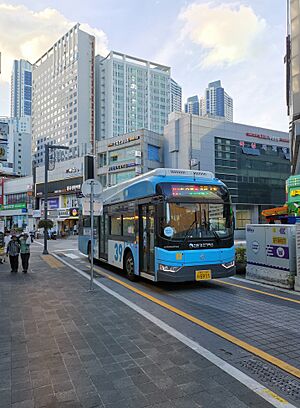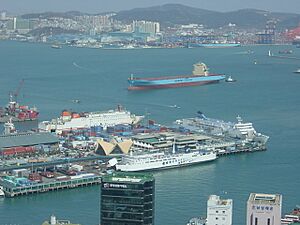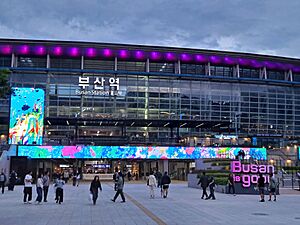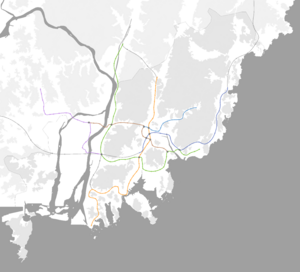Busan facts for kids
Quick facts for kids
Busan
부산 (釜山)
|
|||||
|---|---|---|---|---|---|
|
Metropolitan city
|
|||||
| Busan Metropolitan City 부산광역시 |
|||||
| transcription(s) | |||||
| • Hangul | 부산광역시 | ||||
| • Hanja | 釜山廣域市 | ||||
| • Revised Romanization | Busan-gwangyeoksi | ||||
| • McCune–Reischauer | Pusan-gwangyŏksi | ||||
|
Skyline of Busan and Gwangan Bridge
APEC House
Nampo-dong
Sajik Baseball Stadium
Haeundae Beach
Haedong Yonggungsa
|
|||||
|
|||||
| Country | South Korea | ||||
| Region | Yeongnam | ||||
| Districts | 16 | ||||
| Government | |||||
| • Type | Mayor-Council | ||||
| Area | |||||
| • Metropolitan city | 770.04 km2 (297.31 sq mi) | ||||
| Population
(April 2024)
|
|||||
| • Metropolitan city | 3,343,903 | ||||
| • Density | 4,342.506/km2 (11,247.04/sq mi) | ||||
| • Metro | 4,000,000 | ||||
| • Dialect | Gyeongsang | ||||
| Demonym(s) | Busanian | ||||
| GDP (Nominal, 2023) | |||||
| • Metropolitan city | KRW 114 trillion (US$ 91 billion) |
||||
| • Per capita | US$ 31,611 | ||||
| Area code(s) | (+82) 051 | ||||
| ISO 3166 code | KR-410 | ||||
| Flower | Camellia flower | ||||
| Fish | Mackerel | ||||
| Bird | Seagull | ||||
Busan (Korean: 부산; pronounced [pusan]), officially Busan Metropolitan City, is South Korea's second largest city. It has a population of over 3.3 million people as of 2024. Busan was once known as Pusan.
This city is a major center for business, culture, and education in southeastern South Korea. Its port is the busiest in South Korea and the sixth busiest in the world. The area around Busan, including cities like Ulsan and Daegu, forms South Korea's largest industrial zone.
Busan is divided into 15 main areas called districts and one county. Most of the city is built in narrow valleys between the Nakdong River and the Suyeong River. Mountains separate many of these districts. The Nakdong River is Korea's longest river. Haeundae Beach in Busan is also the country's largest beach.
Busan is a popular place for international meetings. It hosted an APEC summit in 2005. The city is also a big sports hub, having hosted the 2002 Asian Games and some matches for the 2002 FIFA World Cup. You can find the world's largest department store, Shinsegae Centum City, here. In 2014, Busan was recognized by UNESCO as a "City of Film" for its movie industry.
Contents
Understanding the Name "Busan"
The name "Busan" comes from the Korean name used since the late 1400s. It officially replaced the older spelling Pusan in 2000. During the time when Japan ruled Korea, the city's name was pronounced "Fuzan" in Japanese.
The Korean name 釜山 (now written 부산) means "Cauldron Mountain." People believe this was an old name for Mt. Hwangnyeong, a mountain west of the city center. An ancient state in the area, Mt. Geochil, also likely referred to this same mountain.
A Look at Busan's Past
The area where Busan is today has been home to people for a very long time.
- Ancient Times: People lived here during the Neolithic period, using stone tools and fishing for food. Later, in the Bronze Age, people started farming.
- Early Kingdoms: Around the first century, a small kingdom called Koch'ilsan-guk existed here. It later became part of the Silla kingdom and was renamed Dongnae-gun in 757. The famous Buddhist temple Beomeosa was built in 835.
- Goryeo Period: During the Goryeo period (918–1392), the Dongnae Jeong family became important in Korean politics. The hot springs in Dongnae were already well-known. Towards the end of this period, Japanese pirates (called wokou) often attacked. A fortress called Dongnaeeupseong was built to protect the area.
- Joseon Dynasty and Japanese Trade: In 1423, the port of Busan was opened. A special area called a waegwan was set up for Japanese traders. This area was sometimes closed and reopened.
- Japanese Invasions: During the Japanese invasions in the late 1500s, several fortresses in Busan fought back. Many civilians also joined volunteer armies. After the war, Busan was rebuilt, and trade with Japan restarted.
- Later Joseon Period: In 1605, the Songgongsa shrine was built to honor those who died defending Korea. It was later renamed Chungnyeolsa. In 1763, Busan was the first place in Korea to get sweet potatoes, which came from Japan's Tsushima Island.
- Opening to the World: In 1876, Busan became Korea's first international port under the Treaty of Ganghwa. This meant foreign ships could come and go. Consulates from Japan, China, and the UK were set up. In 1908, Busan was connected to the rest of Korea by train. A ferry service to Japan also started in 1909.
- Japanese Colonial Period: From 1910 to 1945, Japan ruled Korea. During this time, Busan grew into a major trading port with Japan. It was the only city in Korea to use steam trams before electric ones.
- Korean War: During the Korean War (1950-1953), Busan was one of the few cities in South Korea that the North Korean army did not capture. Because of this, many Koreans sought safety there, and Busan became a huge refugee camp site. For a while, it even served as the temporary capital of South Korea. UN troops created a defense line around the city called the Pusan Perimeter.
- Modern Busan: In 1963, Busan became a self-governing city, separate from South Gyeongsang Province. It has continued to grow and develop its unique urban style.
Busan's Location and Weather
Busan is located at the very southeastern tip of the Korean Peninsula. Its coastal location has greatly shaped how the city developed. Seoul is about 314 kilometers (195 miles) away.
Busan is surrounded by low mountains to the north and west. The Korea Strait is to its south and east. The Nakdong River Delta is on the west side, and Geumjeongsan, the city's highest mountain, is to the north. The Nakdong River, Korea's longest river, flows through the west and into the Korea Strait. The region around Busan is called Yeongnam.
The closest overseas land to Busan is Tsushima Island in Japan, about 49.5 kilometers (30.8 miles) away. The closest part of mainland Japan is Fukuoka, about 180 kilometers (112 miles) away. Busan and Fukuoka are also sister cities.
Busan's Climate
| Weather chart for Busan | |||||||||||||||||||||||||||||||||||||||||||||||
|---|---|---|---|---|---|---|---|---|---|---|---|---|---|---|---|---|---|---|---|---|---|---|---|---|---|---|---|---|---|---|---|---|---|---|---|---|---|---|---|---|---|---|---|---|---|---|---|
| J | F | M | A | M | J | J | A | S | O | N | D | ||||||||||||||||||||||||||||||||||||
|
35
8
-0
|
50
10
2
|
90
14
5
|
141
18
10
|
156
22
15
|
188
25
18
|
327
28
22
|
267
30
24
|
161
26
20
|
80
23
15
|
50
17
8
|
34
10
2
|
||||||||||||||||||||||||||||||||||||
| temperatures in °C precipitation totals in mm |
|||||||||||||||||||||||||||||||||||||||||||||||
|
Imperial conversion
|
|||||||||||||||||||||||||||||||||||||||||||||||
Busan has a humid subtropical climate, which means it has warm, humid summers and mild winters. Very hot or very cold temperatures are rare. The highest temperature ever recorded was 37.3°C (99.1°F) in August 2016. The lowest was -14.0°C (6.8°F) in January 1915.
From May to July, during late spring and early summer, Busan is usually cooler than inland areas because of the ocean's influence. Late summer and early fall (August and September) are generally hot and humid. The city might experience typhoons during this time, and it's often rainy. Busan is the most typhoon-prone city in South Korea.
October and November are usually the most pleasant months, with clear skies and comfortable temperatures. Winters are cool and quite dry with strong winds, but they are much milder than in other parts of Korea. Busan gets very little snow, averaging only about 4 days per year.
| Climate data for Busan (1991–2020 normals, extremes 1904–present) | |||||||||||||
|---|---|---|---|---|---|---|---|---|---|---|---|---|---|
| Month | Jan | Feb | Mar | Apr | May | Jun | Jul | Aug | Sep | Oct | Nov | Dec | Year |
| Record high °C (°F) | 18.4 (65.1) |
20.3 (68.5) |
22.9 (73.2) |
28.1 (82.6) |
34.0 (93.2) |
33.4 (92.1) |
35.8 (96.4) |
37.3 (99.1) |
35.2 (95.4) |
30.8 (87.4) |
25.6 (78.1) |
20.9 (69.6) |
37.3 (99.1) |
| Mean daily maximum °C (°F) | 8.2 (46.8) |
10.2 (50.4) |
13.8 (56.8) |
18.2 (64.8) |
22.0 (71.6) |
24.6 (76.3) |
27.5 (81.5) |
29.5 (85.1) |
26.4 (79.5) |
22.5 (72.5) |
16.6 (61.9) |
10.4 (50.7) |
19.2 (66.6) |
| Daily mean °C (°F) | 3.6 (38.5) |
5.4 (41.7) |
9.1 (48.4) |
13.8 (56.8) |
17.9 (64.2) |
21.0 (69.8) |
24.4 (75.9) |
26.1 (79.0) |
22.6 (72.7) |
17.9 (64.2) |
11.9 (53.4) |
5.8 (42.4) |
15.0 (59.0) |
| Mean daily minimum °C (°F) | −0.1 (31.8) |
1.5 (34.7) |
5.3 (41.5) |
10.1 (50.2) |
14.6 (58.3) |
18.3 (64.9) |
22.1 (71.8) |
23.7 (74.7) |
19.8 (67.6) |
14.5 (58.1) |
8.3 (46.9) |
2.0 (35.6) |
11.7 (53.1) |
| Record low °C (°F) | −14.0 (6.8) |
−12.6 (9.3) |
−9.7 (14.5) |
−1.5 (29.3) |
5.4 (41.7) |
9.3 (48.7) |
13.8 (56.8) |
15.4 (59.7) |
9.6 (49.3) |
1.8 (35.2) |
−6.5 (20.3) |
−12.0 (10.4) |
−14.0 (6.8) |
| Average precipitation mm (inches) | 34.5 (1.36) |
49.6 (1.95) |
89.7 (3.53) |
140.9 (5.55) |
155.9 (6.14) |
188.4 (7.42) |
326.8 (12.87) |
266.5 (10.49) |
160.6 (6.32) |
79.6 (3.13) |
50.4 (1.98) |
33.8 (1.33) |
1,576.7 (62.07) |
| Average precipitation days (≥ 0.1 mm) | 5.4 | 5.9 | 8.3 | 9.2 | 9.1 | 10.4 | 13.6 | 11.9 | 9.2 | 5.3 | 6.0 | 4.7 | 99.0 |
| Average snowy days | 1.4 | 1.2 | 0.5 | 0.0 | 0.0 | 0.0 | 0.0 | 0.0 | 0.0 | 0.0 | 0.1 | 0.9 | 4.1 |
| Average relative humidity (%) | 46.8 | 49.4 | 56.0 | 61.1 | 68.3 | 76.8 | 83.4 | 78.5 | 72.6 | 62.7 | 56.3 | 48.1 | 63.3 |
| Mean monthly sunshine hours | 203.1 | 189.4 | 202.0 | 212.6 | 228.5 | 180.3 | 172.3 | 199.2 | 173.8 | 212.1 | 195.5 | 205.6 | 2,374.4 |
| Percent possible sunshine | 63.6 | 59.3 | 52.0 | 53.6 | 51.1 | 41.4 | 37.5 | 48.2 | 44.9 | 59.6 | 62.6 | 67.0 | 52.3 |
| Average ultraviolet index | 2 | 4 | 6 | 7 | 9 | 10 | 10 | 10 | 8 | 5 | 3 | 2 | 6 |
| Source 1: Korea Meteorological Administration (percent sunshine 1981–2010) | |||||||||||||
| Source 2: Weather Atlas (UV) | |||||||||||||
City Divisions
In 1957, Busan started dividing itself into six gu (districts). Today, Busan has fifteen gu and one gun (county).
| Subdivision | Korean | Area (km2) |
Population (January 2018) |
Map of Busan |
|---|---|---|---|---|
| Buk District | 북구; 北區 | 39.36 | 303,955 | |
| Busanjin District | 부산진구; 釜山鎭區 | 29.70 | 372,922 | |
| Dong District | 동구; 東區 | 9.73 | 90,668 | |
| Dongnae District | 동래구; 東萊區 | 16.63 | 271,350 | |
| Gangseo District | 강서구; 江西區 | 181.50 | 123,636 | |
| Geumjeong District | 금정구; 金井區 | 65.27 | 249,054 | |
| Haeundae District | 해운대구; 海雲臺區 | 51.47 | 417,174 | |
| Jung District | 중구; 中區 | 2.83 | 45,821 | |
| Nam District | 남구; 南區 | 26.81 | 278,681 | |
| Saha District | 사하구; 沙下區 | 41.75 | 337,423 | |
| Sasang District | 사상구; 沙上區 | 36.09 | 233,443 | |
| Seo District | 서구; 西區 | 13.93 | 111,906 | |
| Suyeong District | 수영구; 水營區 | 10.21 | 181,526 | |
| Yeongdo District | 영도구; 影島區 | 14.15 | 124,918 | |
| Yeonje District | 연제구; 蓮堤區 | 12.08 | 207,396 | |
| Gijang County | 기장군; 機張郡 | 218.32 | 164,546 |
Busan's Economy
Busan is Korea's second-largest city and a major shipping center in Northeast Asia. It acts as a gateway to the Eurasian continent. In 2022, the city's economy was worth about 104 trillion Korean Won.
The city's economy mainly relies on services (70.3%), manufacturing (19.8%), and construction (5.9%).
The port of Busan is the sixth-largest port in the world. In 2020, it handled over 21 million shipping containers. The port has 43 berths (places for ships to dock). It is part of the "21st Century Maritime Silk Road," a major shipping route connecting Asia, Africa, and Europe.
Busan is also a hub for ocean science and research. It is home to important organizations like the Korea Maritime Institute and the Korea Institute of Ocean Science and Technology.
The city is well-known for its MICE industry, which stands for Meetings, Incentives, Conferences, and Exhibitions. Busan has great facilities like BEXCO to host large international events. It hosted the 2005 APEC Economic Leaders' Meeting and the 2014 ASEAN–Republic of Korea Commemorative Summit.
Busan is also a financial center. The Korea Exchange (KRX), which is Korea's only stock exchange, is located here. Many financial companies also have their offices in Busan.
Shopping and business areas are found all over the city. The two biggest central business districts are Seomyeon and Gwangbok-dong/Nampo-dong. There are four main shopping areas: Seomyeon, Gwangbok-dong, Busan Daehak-ga, and Centum City.
Seomyeon Station is one of Korea's busiest subway stations. It has many underground shops selling clothes and shoes. Many Korean and international banks have their main offices in Seomyeon. This area is known for shopping and entertainment. It also has "Seomyeon Medical Street," with over 160 clinics for cosmetic surgery, skin care, eye care, and dentistry. Next to Seomyeon is Bujeon Market, the city's largest traditional market.
The Gwangbok-dong, Nampo-dong, and Jungang-dong areas make up the older central business district. Some restaurants here use family recipes passed down for generations. Jagalchi Market, a large seafood market, is in this area. The Gukje Market is also nearby. Jungang-dong has many international law offices and the international ferry terminal for routes to Japan.
Busan has many large department stores, including Lotte Department Store and Shinsegae Premium Outlet. You can also find big supermarket chains like Homeplus, e-mart, and Costco.
Learning in Busan
Busan has many universities and other schools.
Universities with Graduate Schools
- Busan University of Foreign Studies (BUFS)
- Busan Presbyterian University
- Busan National University of Education (BNUE)
- Catholic University of Pusan
- Dongseo University
- Dong-A University
- Dong-eui University
- Inje University – Busan Campus
- Kosin University
- Korea Maritime and Ocean University
- Kyungsung University
- Pukyong National University (PKNU)
- Pusan National University (PNU)
- Silla University
- Tongmyong University
- Youngsan University
Other Higher Education Institutes
- Busan Arts College
- Busan Institute of Science and Technology (BIST)
- Busan Kyungsang College
- Busan Polytechnic College
- Daedong College
- Dong-Pusan College
- Dongju College
- Korea Institute of Maritime and Fisheries Technology
Schools for Foreign Students
- Busan Foreign Language High School
- Busan Foreign School (for students from Pre-Kindergarten to 12th Grade)
- Busan Japanese School (釜山日本人学校, 부산일본인학교)
- International School of Busan (for students from Pre-Kindergarten to 12th Grade)
- Overseas Chinese Elementary School Busan
- Overseas Chinese High School, Busan
High Schools
- Keumjeong High School (1986)
- Kyeongwon High School (1986)
- Gaya High School
Culture and Fun in Busan
Busan offers many interesting places to visit, from old shops to unique restaurants.
Parks, Beaches, and Special Places
Busan is often called Korea's summer capital. It attracts many visitors to its six beaches. Haeundae Beach is Busan's most famous beach. It has luxury hotels and a boardwalk. This beach is often seen in South Korean movies and TV shows. Gwangalli Beach has cafes, bars, and restaurants along the shore, with views of the Grand Gwangan Bridge. Other beaches include Dadaepo Beach and Songdo Beach.
Dongbaekseom is a beautiful island at the end of Haeundae Beach. It has a thick forest of camellia and pine trees. You can walk along paths and visit the Nurimaru APEC House, which was built for a big meeting in 2005. Songjeong beach is just north of Haeundae Beach.
Geumjeongsan mountain to the west is a popular spot for hiking. Near Pusan National University, you'll find student theaters, cafes, and restaurants. There are also outdoor cultural performances on weekend nights. Nearby is Beomeosa, the city's main Korean Buddhist temple.
Yongdusan Park is a large park with the Busan Tower, an art gallery, and the Busan Aquarium. The park has about seventy different types of trees and hosts cultural events.
Dongnae District is a traditional area with natural hot springs called Dongnae Oncheon. This spa area has many baths, hotels, and shops. Chungnyeolsa is a shrine honoring soldiers who died fighting the Japanese in the 1500s.
Taejongdae is a natural park on Yeongdo island, with cliffs facing the open sea.
The "Foreigners' Shopping Street," also known as "Texas Street," is near the Port of Busan and the Busan Train Station. It has many businesses that serve the local Russian community and foreign ship crews. This area used to be Chinatown and still has a Chinese school.
Haedong Yonggung temple is one of three special places related to the Goddess Buddha.
Gamcheon Cultural Village was built in the 1950s on a mountain slope. The houses are built like steps, giving it a unique look. It's often called the "Machu Picchu of Korea" and attracts many tourists.
Busan Citizens Park is a large park in the Busanjin District. It used to be a military base.
Huinnyeoul Culture Village was formed by Korean War refugees. It offers great views of Busan's ports. This village has been featured in movies like The Attorney and Nameless Gangster: Rules of the Time. Its small, closely built houses show Busan's unique style as a city of the sea and hills. The village is becoming more popular with new cafes and workshops.
Millac Waterfront Park is Korea's first waterfront park. It combines the oceanfront with public spaces for relaxation. The park is between Haeundae Beach and Gwangalli Beach. It has colorful paths, flower gardens, and benches. You can even dip your feet in the water during high tide.
Nampo-dong is a central area for shopping and cafes. The areas around Pukyong National University and Kyungsung University also have many cafes, bars, and restaurants popular with students.
Daejeo Ecological Park is a large park and a home for migratory birds at the Nakdong River Estuary. It has wetlands and natural grasslands. Many festivals are held here, like the Nakdong Riverside Cherry Blossom Festival and the Busan Nakdong River Canola Flower Festival.
Ilgwang Beach is a long, white-sand beach, popular with families because the water is shallow. Every summer, the Gaetmaeul Outdoor Drama Festival takes place here, with traditional Korean music and performances.
Kiswire Museum helps visitors understand wire, an important material for industry. The museum building itself is unique, with its roof supported by 38 cables. It also displays art made from wires.
Jeonpo Cafe Street in Seomyeon, Busan is a busy area with many cafes. This street used to have hardware stores, but since 2010, it has become a popular spot for unique cafes.
Busan is planning to build the world's first floating city, called Oceanix City. It is expected to be ready for people to live in by 2025.
Temples and Historical Sites
- Beomeosa Temple
- Busanjinjiseong Fortress
- Chungnyeolsa Shrine
- Dongnaeeupseong Fortress
- Haedong Yonggungsa Temple
- United Nations Memorial Cemetery (a special place honoring soldiers from the Korean War)
- Yeongdo Bridge
Arts and Entertainment
Busan hosts the Busan International Film Festival (BIFF) every fall at the Busan Cinema Center. It is one of Asia's most popular film festivals. Busan also holds the Busan Biennale, an international art event every two years.
The city also hosts the One Asia Festival, a large K-pop festival that started in 2016. This event helps Busan become a center for K-pop culture.
In 2012, artist Hendrik Beikirch painted Asia's tallest mural, "Fisherman Portrait," on a building near Millak Raw Fish Town.
Busan has many performance venues, including the Busan Cultural Center and the Busan Cinema Center.
Festivals and Events
Busan celebrates many festivals throughout the year.
- May: Joseon Tongsinsa Festival (celebrating historical exchange with Japan), Busan Port Festival.
- August: Busan Sea Festival (at Haeundae Beach), Busan International Rock Festival.
- October: Busan International Film Festival (Asia's largest film festival), Busan Fireworks Festival, One Asia Festival (K-pop music festival).
- November: G-Star (Korea's largest gaming exhibition), e-Sports World Championship.
- December: Busan Christmas Tree Festival.
Major Performance Venues
| No. | Facility | Number of Seats |
|---|---|---|
| 1 | Busan Cultural Center | 2,389 |
| 2 | Busan Citizens' Hall | 1,941 |
| 3 | BEXCO Auditorium | 2,644 |
| 4 | Busan National Gugak Center | 974 |
| 5 | Busan Cinema Center Haneulyeon Theatre | 841 |
| 6 | Korea National Maritime Museum | 311 |
Museums to Explore
Busan has many museums, including:
- Busan Museum
- Busan Museum of Art
- Museum of Contemporary Art Busan
- Busan Museum of Movies
- Busan Modern History Museum
- Korea National Maritime Museum
- Kiswire Museum
- United Nations Peace Memorial Hall
Traditional Foods to Try
Busan has unique traditional dishes.
- Dongnae pajeon: This is a type of Korean savory pancake made with green onions, chili peppers, and seafood. It has a thick batter.
- Milmyeon: During the Korean War, many refugees came to Busan. They adapted their traditional cold noodle soup, naengmyeon, by using wheat flour instead of buckwheat. This created milmyeon.
- Dwaeji gukbap: This is a hearty pork soup that became popular during the Korean War. It is now enjoyed nationwide.
- Nangchae-Jokbal: This dish features pork trotters (pig's feet) served with vegetables like cucumbers and onions, and a mustard sauce.
-
Dongnae pajeon
Hot Springs and Spas
Busan has the largest hot spring resorts in Korea. Busan's Oncheon is the oldest hot spring spa in Korea.
- Spa Land (Haeundae District)
- HurShimChung Hot Spring Resorts and Spa Town (Dongnae District)
- Haeundae Hot Spring Resorts and Spa Towns (Haeundae District)
Busan in Movies and TV
Busan is a popular place for filming movies and TV shows. It's known for its unique look, with hills and the sea.
- The Busan International Film Festival is often called the "Cannes of Asia." It attracts many famous people from the film world.
- Busan has been a filming location for movies like Marvel's Black Panther and Apple's Pachinko.
- Korean movies like Train to Busan, Old Boy, and Decision to Leave were also filmed here.
- The popular K-Drama Reply 1997 highlights the unique Gyeongsang dialect spoken in Busan.
- Many stories set in Busan are crime dramas. It often appears as a place where characters escape to or a disaster area. For example, Train to Busan is about an escape to Busan.
- In the early 2000s, it became easier to get permits for filming in Busan, which helped the city become a popular film location. The movie Haeundae was a huge success, attracting 10 million viewers.
People of Busan
| Historical population | ||
|---|---|---|
| Year | Pop. | ±% |
| 1950 | 947,770 | — |
| 1960 | 1,154,129 | +21.8% |
| 1970 | 1,842,259 | +59.6% |
| 1980 | 3,159,766 | +71.5% |
| 1990 | 3,798,113 | +20.2% |
| 2000 | 3,662,884 | −3.6% |
| 2010 | 3,414,950 | −6.8% |
| 2020 | 3,349,016 | −1.9% |
Between 1945 and 1951, Busan's population grew from 280,000 to 840,000 people. It has since decreased from 3,513,777 in 2015 to 3,266,598 in 2024. This change is partly because South Korea's economy has shifted towards high-tech industries, which are mostly located around Seoul.
Religion in Busan
Religion in Busan (2024) Not religious (48%) Buddhism (29%) Protestantism (14%) Catholicism (7%) Others (2%)
In 2024, about 29% of people in Busan followed Buddhism. About 21% followed Christianity (14% Protestantism and 7% Catholicism). Another 2% followed other religions. Almost half of the population (48%) did not identify with a religion.
Sports in Busan
Busan considered bidding for the 2032 Summer Olympics.
Sports Teams and Facilities
| Club | League | Stadium | Stadium Capacity | Sports Type |
|---|---|---|---|---|
| Lotte Giants | KBO League | Sajik Baseball Stadium | 28,500 | Baseball |
| Busan IPark | K League 2 | Busan Gudeok Stadium | 12,349 | Football |
| Busan BNK Sum | WKBL | Sajik Arena | 14,099 | Basketball |
Baseball
Since 1982, Busan has been home to the Lotte Giants baseball team, who play in the Korea Professional Baseball league. Busan is known as the "capital of baseball" in Korea, with very excited fans. The Lotte Giants play at Sajik Baseball Stadium.
Football
The city has a K League football (soccer) club, the Busan IPark. Busan is also home to the Busan Transportation Corporation FC in the K3 League.
Basketball
Since 2019, Busan has been home to the Busan BNK Sum women's basketball team, which plays in the Women's Korean Basketball League. They currently play at the Sajik Arena.
2002 FIFA World Cup
Busan hosted matches for the 2002 FIFA World Cup, which was held in South Korea and Japan. Games between France and Uruguay, and South Korea against Poland, took place at the Busan Asiad Stadium.
2002 Asian Games
The 2002 Asian Games were held in Busan from September 29 to October 14, 2002. About 9,900 athletes from 44 countries competed in 38 sports. Many sports venues, including Busan Asiad Stadium, were used. The mascot was a seagull named "Duria."
Getting Around Busan
Bus Services
Busan has two main bus terminals that connect it to other cities in Korea. There are 134 city bus routes that cover all parts of Busan. Some buses from nearby cities also serve Busan.
City Buses
City buses operate 160 routes. There are express buses that travel quickly through tunnels and overpasses, and regular city buses that stop at every bus stop. Airport buses connect Gimhae International Airport to the city center.
Airport Limousine Buses
Gimhae Airport Limousine Buses are a fast way to get between Gimhae International Airport and downtown. As of 2012, there are three routes.
Intercity Buses
Intercity buses to eastern areas like Gyeongnam and Gyeongbuk leave from the Busan Central Bus Terminal. Buses to western Gyeongnam and Jeolla Province leave from the Busan West Bus Terminal. There are also intercity bus terminals in Haeundae and Dongnae for other routes.
Travel by Sea
Ferries leave from the International Ferry Terminal at Busan Port to Japanese ports. You can travel to Izuhara and Hitakatsu on Tsushima Island, and to the cities of Shimonoseki, Fukuoka, and Osaka on Japan's mainland.
- The PanStar Ferry travels between Busan and Osaka.
- The Seaflower 2 ferry goes to Tsushima.
- The Seonghee ferry connects Busan to Shimonoseki.
- The Camellia ferry travels to Fukuoka overnight.
- High-speed hydrofoils called Beetles and Kobees also go to Fukuoka. They make the trip in less than 3 hours.
Train Travel
Busan is connected by several train lines. The most important is the Gyeongbu Line, which links Busan to major cities like Seoul, Daejeon, and Daegu. High-speed KTX trains on this line can get you to Seoul in about 150 minutes. The Gyeongbu Line ends at Busan Station.
The SRT train service started in 2016. It connects the Gangnam area of Seoul with major cities.
Subway System
Busan has six subway lines as of January 2017. You can transfer between lines at stations like Seomyeon Station (Line 1, 2) and Yeonsan Station (Line 1, 3).
Air Travel
Busan is served by Gimhae International Airport in Gangseo District. This airport is connected by the Busan-Gimhae Light Rail Transit.
A new airport is being built on the southern end of Gadeokdo island. This will be South Korea's first airport built offshore.
Busan's International Connections
Sister Cities
Busan is a "sister city" with many coastal cities and regions around the world. This means they have special friendly relationships.
 Kaohsiung, Taiwan (1966)
Kaohsiung, Taiwan (1966) Los Angeles, US (1967)
Los Angeles, US (1967) Shimonoseki, Japan (1976)
Shimonoseki, Japan (1976) Barcelona, Spain (1983)
Barcelona, Spain (1983) Rio de Janeiro, Brazil (1985)
Rio de Janeiro, Brazil (1985) Vladivostok, Russia (1992)
Vladivostok, Russia (1992) Shanghai, China (1993)
Shanghai, China (1993) Surabaya, Indonesia (1994)
Surabaya, Indonesia (1994) State of Victoria, Australia (1994)
State of Victoria, Australia (1994) Ho Chi Minh City, Vietnam (1995)
Ho Chi Minh City, Vietnam (1995) Tijuana, Mexico (1995)
Tijuana, Mexico (1995) Auckland, New Zealand (1996)
Auckland, New Zealand (1996) Valparaíso, Chile (1999)
Valparaíso, Chile (1999) Montreal, Canada (2000)
Montreal, Canada (2000) Western Cape, South Africa (2000)
Western Cape, South Africa (2000) Istanbul, Turkey (2002)
Istanbul, Turkey (2002) Dubai, UAE (2006)
Dubai, UAE (2006) Fukuoka, Japan (2007)
Fukuoka, Japan (2007) Chicago, US (2007)
Chicago, US (2007) Saint Petersburg, Russia (2008)
Saint Petersburg, Russia (2008) Phnom Penh, Cambodia (2009)
Phnom Penh, Cambodia (2009) Mumbai, India (2009)
Mumbai, India (2009) Thessaloniki, Greece (2010)
Thessaloniki, Greece (2010) Casablanca, Morocco (2011)
Casablanca, Morocco (2011) Cebu Province, Philippines (2011)
Cebu Province, Philippines (2011) Yangon, Myanmar (2013)
Yangon, Myanmar (2013) Gdynia, Poland (2020)
Gdynia, Poland (2020)
Friendship Cities
Busan also has 11 friendship cities in six countries.
 Shenzhen, China (2007)
Shenzhen, China (2007) Tianjin, China (2007)
Tianjin, China (2007) Osaka, Japan (2008)
Osaka, Japan (2008) Chongqing, China (2010)
Chongqing, China (2010) Bangkok, Thailand (2011)
Bangkok, Thailand (2011) Beijing, China (2013)
Beijing, China (2013) Nagasaki, Japan (2014)
Nagasaki, Japan (2014) Bandar Abbas, Iran (2016)
Bandar Abbas, Iran (2016) Ulaanbaatar, Mongolia (2016)
Ulaanbaatar, Mongolia (2016) Panama City, Panama (2016)
Panama City, Panama (2016) Guangzhou, China (2019)
Guangzhou, China (2019)
Sister Ports
The Port of Busan also has 6 sister ports around the world.
 – Port of Southampton, UK (1978)
– Port of Southampton, UK (1978) – Port of Miami, US (1981)
– Port of Miami, US (1981) – Port of Osaka, Japan (1985)
– Port of Osaka, Japan (1985) – Port of Rotterdam, Netherlands (1985)
– Port of Rotterdam, Netherlands (1985) – Port of New York & New Jersey, US (1988)
– Port of New York & New Jersey, US (1988) – Port of Shanghai, China (1994)
– Port of Shanghai, China (1994)
Famous People from Busan
Many well-known actors, singers, and athletes come from Busan.
- Ahn Bo-hyun (born 1988), actor
- Choi Ye-won / Arin (born 1999), singer and member of Oh My Girl
- Choi Ji-woo (born 1975), actress
- Daniel Dae Kim (born 1968), Korean-American actor
- Gong Yoo (born in 1979), actor
- Hwang Min-hyun (born 1995), singer and actor
- Jang Wooyoung (born 1989), singer and member of 2PM
- Jeon Jungkook (born 1997), singer and member of BTS
- Jung Eun-ji (born 1993), singer and member of Apink
- Jo Yu-ri (born 2001), singer and actress
- Kang Daniel (born in 1996), singer
- Kang Seung-yoon (born 1994), singer and member of WINNER
- Kim Minjeong / Winter (born in 2001), singer and member of Aespa
- Lee Joon-gi (born 1982), actor and singer
- Lee Jihoon / Woozi (born 1996), singer and member of Seventeen
- Nam Joo-hyuk (born 1994), actor and model
- Park Ji-hoon (born 2000), singer and member of Treasure
- Park Jimin (born 1995), singer and member of BTS
- Sandara Park (born 1984), singer and actress
- Song Kang-ho (born 1967), actor, known for the movie Parasite
- Yang Jeong-in / I.N (born 2001), singer and member of Stray Kids
- Im Si-wan (born 1988), singer and actor
See also
 In Spanish: Busan para niños
In Spanish: Busan para niños


